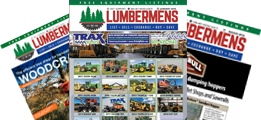-Tires size: 23.1.26 (comes with chains) -No winch -Everything works and operates as it should. Nothing wrong with it and ready to go to work -If interested (for $3K extra), owner will include with sale another entire CAT 518 Tree Harvester with 5000hrs on the drivetrain, which is the only reason why owner bought the […]
Revive and Thrive: Essential Maintenance Tips for Used Forestry Equipment
As the forestry industry continues to expand, there is a growing demand for used forestry equipment. These machines offer a cost-effective solution for businesses looking to expand their fleet or replace outdated equipment. However, maintaining used forestry equipment is essential to ensure optimal performance, longevity, and safety.

In this blog, we will explore comprehensive maintenance tips tailored specifically for used forestry equipment, shedding light on common challenges and providing valuable insights on how to prevent damage and extend the lifespan of this essential machinery.
Cleaning and Upkeep
Regular cleaning and upkeep are essential for ensuring the proper functioning and longevity of used forestry equipment. Debris accumulation, if left unchecked, can significantly hinder the equipment’s performance and potentially lead to malfunctions.

Therefore, it is vital to implement a strict cleaning regimen that includes removing debris and build-up, washing the equipment regularly, clearing grilles and screens of any obstructions, and applying rust inhibitors to susceptible areas to safeguard the equipment from corrosion.
Engine Maintenance
Regular checks and timely oil changes are essential for engine health. Additionally, thorough inspection and maintenance of air filters are necessary to ensure optimal airflow, while meticulous care of the fuel system prevents potential malfunctions and ensures uninterrupted operation. It’s also important to conduct regular checks on the cooling system to prevent overheating and ensure the proper functioning of the engine.

Regularly inspecting the belts, hoses, and electrical connections can help identify potential issues early on, while keeping the engine bay clean from debris and dirt can prevent complications and extend the engine’s lifespan. Keeping a detailed maintenance log can help track the engine’s performance over time and indicate when certain components may need replacement or repair.
Hydraulic System Care
The hydraulic system is a critical component of forestry equipment, and its proper maintenance is paramount. Frequent inspection of hydraulic lines, hoses, and fittings is necessary to identify and address any signs of wear, preventing potential failures.
Carefully monitoring the condition of seals and connections is crucial for preventing leaks and maintaining the system’s functionality. Ensuring proper tension and alignment of belts, as well as keeping the hydraulic reservoir clean, are also essential for optimal performance.
Regularly checking and replacing hydraulic filters based on the manufacturer’s guidelines is crucial to ensure that contaminants are effectively removed from the fluid, preserving the integrity of the system.
Electrical System Checks
The proper functioning of the electrical system is fundamental to the safety and efficiency of forestry equipment. Regular battery maintenance, including checking the electrolyte levels, cleaning terminals, and ensuring proper charging, is essential to prevent unexpected breakdowns.

Additionally, comprehensive inspections of wiring and connections, including the use of thermal imaging to identify potential hotspots, are crucial to prevent potential electrical failures. Ensuring that all lighting and signals, including headlights, taillights, turn signals, and warning lights, are operational is essential for visibility and hazard communication, especially in low-light conditions.
It is also important to inspect and test all control switches, sensors, and relays to ensure that they are responsive and to identify and address any signs of wear, corrosion, or overheating. Regularly calibrating and testing electrical instruments and gauges, such as ammeters and voltmeters, will help maintain accurate and reliable readings, contributing to overall equipment safety and efficiency.
Tire and Track Maintenance
Tire and track maintenance is crucial for the optimal performance and safety of forestry equipment. Regular inspections are essential to assess wear and damage, including checking for signs of punctures, cuts, and uneven wear patterns.

Additionally, it is important to monitor proper inflation and tire pressure checks to ensure that the equipment operates safely and efficiently. Adherence to manufacturer-recommended replacement guidelines is vital for minimizing the risk of accidents and operational downtime.
It’s also important to maintain proper alignment and balance to ensure even wear and consistent performance of tires or tracks. By staying vigilant with tire and track maintenance, equipment operators can maximize safety, efficiency, and overall equipment lifespan.
Lubrication and Greasing
Proper lubrication is crucial for minimizing friction and wear on moving parts of forestry equipment. Regularly identifying and greasing key lubrication points, selecting suitable lubricants based on the equipment’s specifications, and understanding the importance of consistent lubrication is vital for the equipment’s longevity.
This proactive approach significantly contributes to reducing maintenance costs and preventing premature wear and tear of essential components. It’s also important to adhere to the manufacturer’s recommendations for lubrication intervals and types of grease suitable for specific components.
Seasonal and Long-Term Storage Tips
When forestry equipment is not in use, it’s crucial to follow proper storage practices to preserve its condition and functionality. By preparing the equipment for off-season storage, protecting it against weather elements, and implementing best practices for long-term storage, you can minimize deterioration and prolong the machinery’s lifespan during periods of inactivity.

This can involve thorough cleaning to remove any dirt or debris, applying protective coatings to prevent corrosion, and storing batteries in a controlled environment to maintain their health. Additionally, it’s important to consult the equipment’s manual for specific procedures tailored to long-term storage to ensure the equipment remains in optimal condition.
Upgrading and Modernizing Used Equipment
Considering technological upgrades and retrofitting used equipment with newer components can not only enhance its performance but also extend its usability. However, it is crucial to conduct a diligent cost-benefit analysis to determine the practicality and potential return on investment of such upgrades.
Balancing modernization efforts with the equipment’s operational lifespan and expected usage can lead to more informed and advantageous decisions for long-term efficiency and productivity. This may include choosing the right used forestry equipment consulting with equipment manufacturers to identify compatible modernization options and evaluating how these upgrades can positively impact productivity and cost-effectiveness.
Record Keeping and Documentation
Maintaining comprehensive maintenance logs, scheduling regular check-ups, and diligently documenting all maintenance and repair activities are invaluable practices for enhancing the equipment’s operational history and optimizing its resale value.

Additionally, it’s important to keep records of all inspections, repairs, and part replacements to provide a complete maintenance history and demonstrate the equipment’s care and condition for potential buyers.
Conclusion
In conclusion, the meticulous maintenance of used forestry equipment is a critical aspect of ensuring its longevity, operational efficiency, and safety. By adhering to a robust maintenance schedule and integrating essential upkeep practices into their operations, businesses can maximize the value and productivity of their machinery while minimizing operational downtime and repair costs.
Additionally, carefully considering factors, such as equipment usage history, maintenance records, wear and tear, and the reputation of the seller before buying used forestry equipment will empower businesses to make well-informed and advantageous investment decisions, thereby optimizing their operational capabilities and fostering sustainable growth and success within the forestry industry.

